Abstract
Two pigeons were exposed to a multiple schedule of reinforcement: in the presence of one discriminative stimulus, key pecks produced grain according to a fixed-ratio schedule; in the presence of a second discriminative stimulus, key pecks produced grain according to a variable-ratio schedule. The key-peck requirements in the two components were increased in successive stages from 50 to 125 responses. Live target pigeons were restrained at the rear of the chamber. Attacks against the targets were automatically recorded, and a variety of measures of attack behavior were taken. Attacks, when they occurred, always followed grain presentation. All measures revealed higher levels of attack during the fixed-ratio component at all parameter values. All measures generally increased with increases in fixed-ratio values with both birds, and with increases in variable-ratio values with one bird. With the other bird, only the per cent of reinforcements followed by attack increased with increases in variable-ratio value; all other measures first increased and then decreased. Both increasing and bitonic functions relating induced attack to schedule parameters have been reported in experiments usually employing a single measure of attack. The measures have varied widely among these experiments. It is suggested that further studies of induced attack examine a wider range of schedule parameters and that relationships among measures be studied.
Full text
PDF
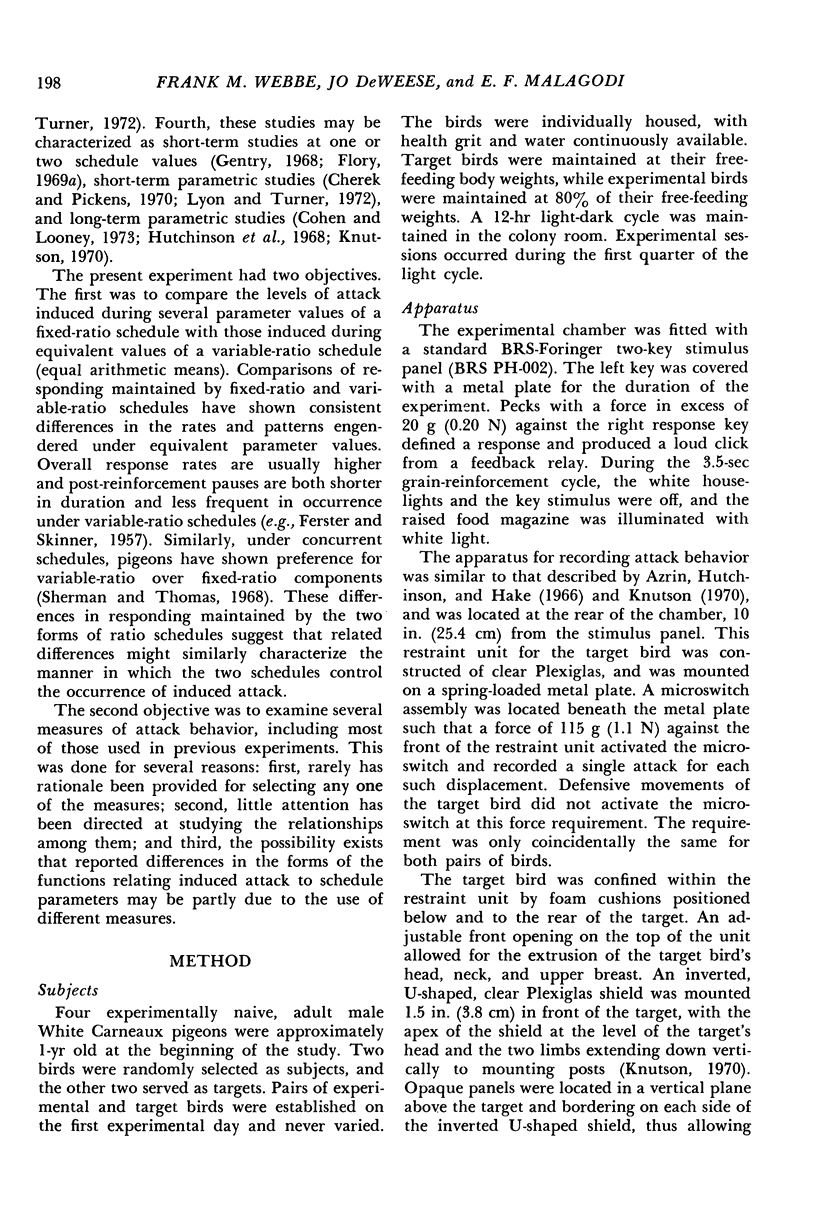
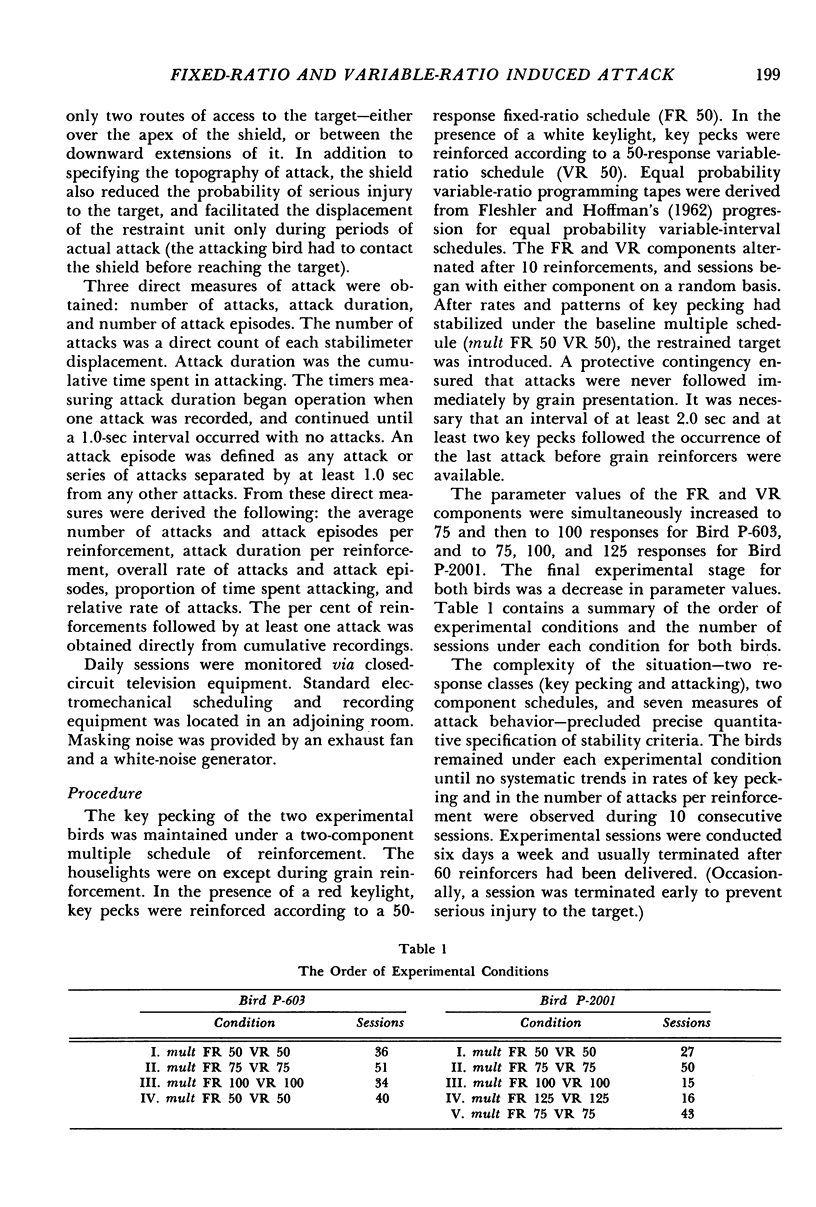

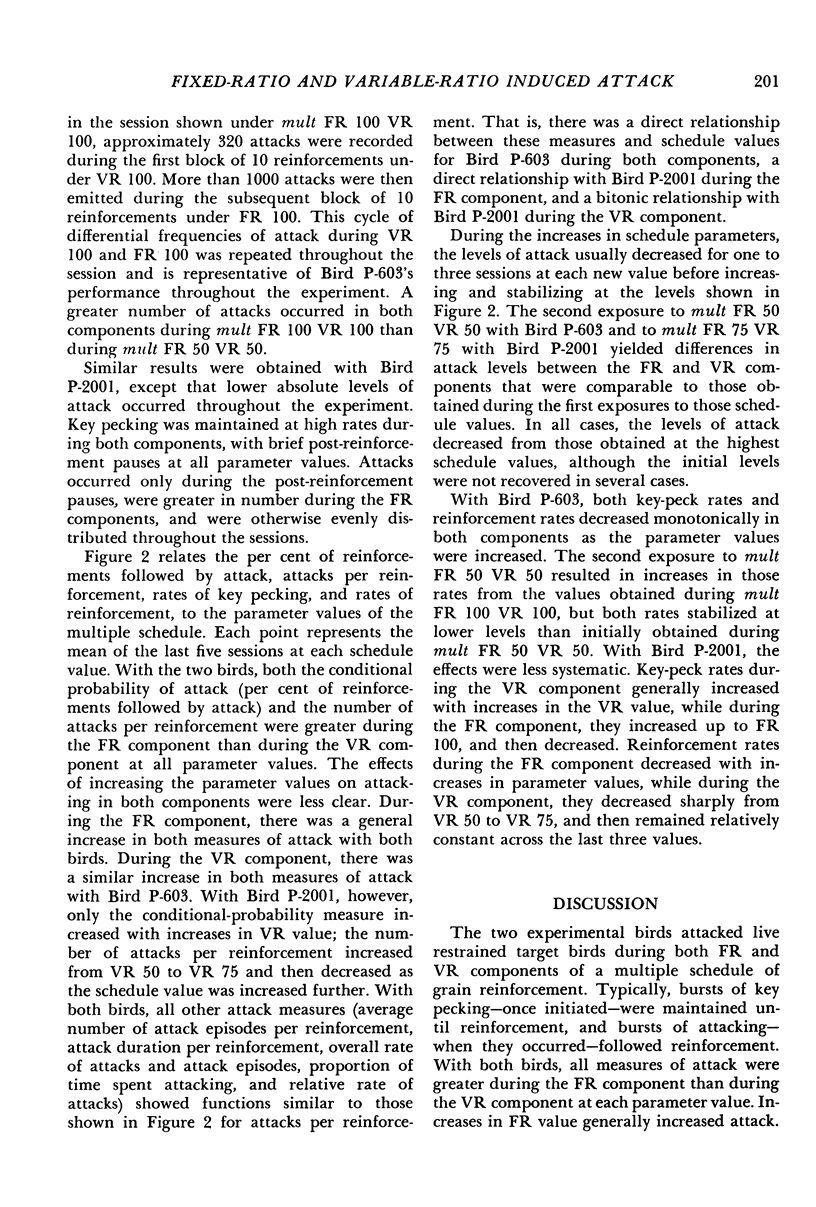

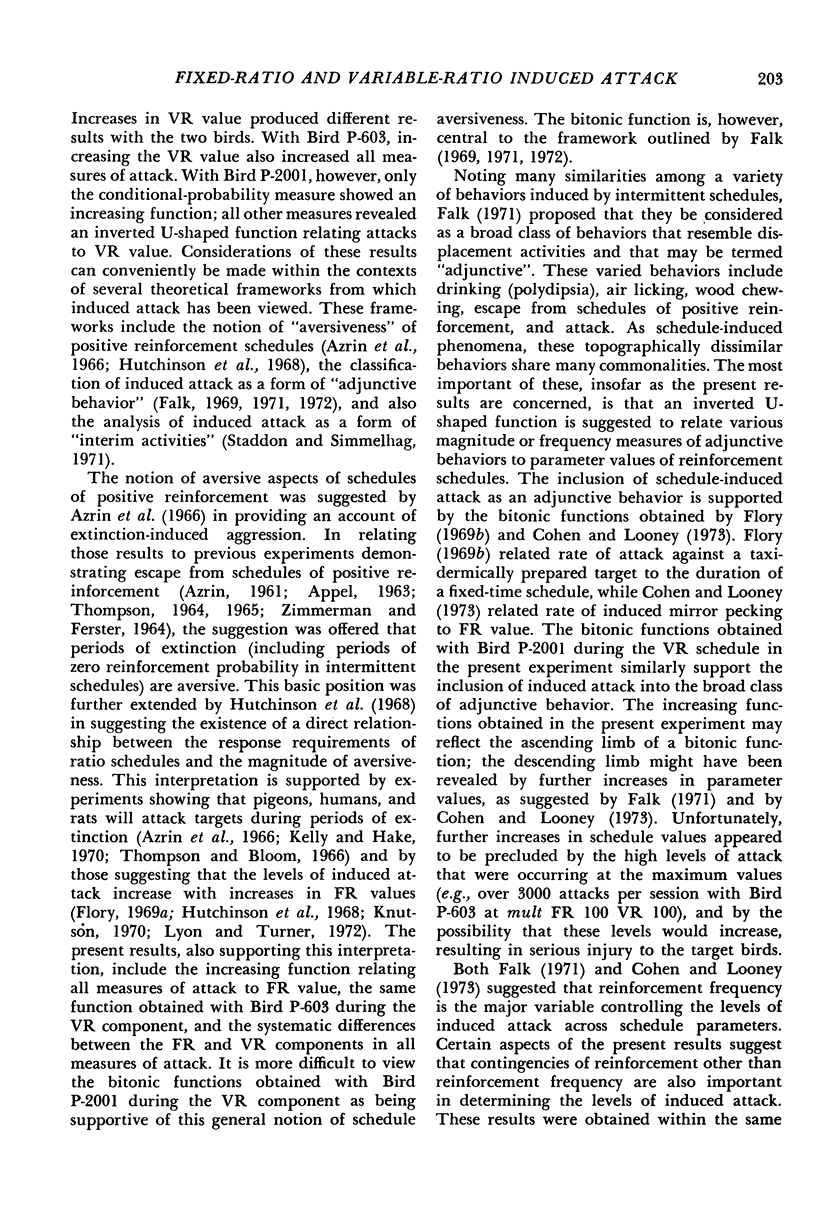
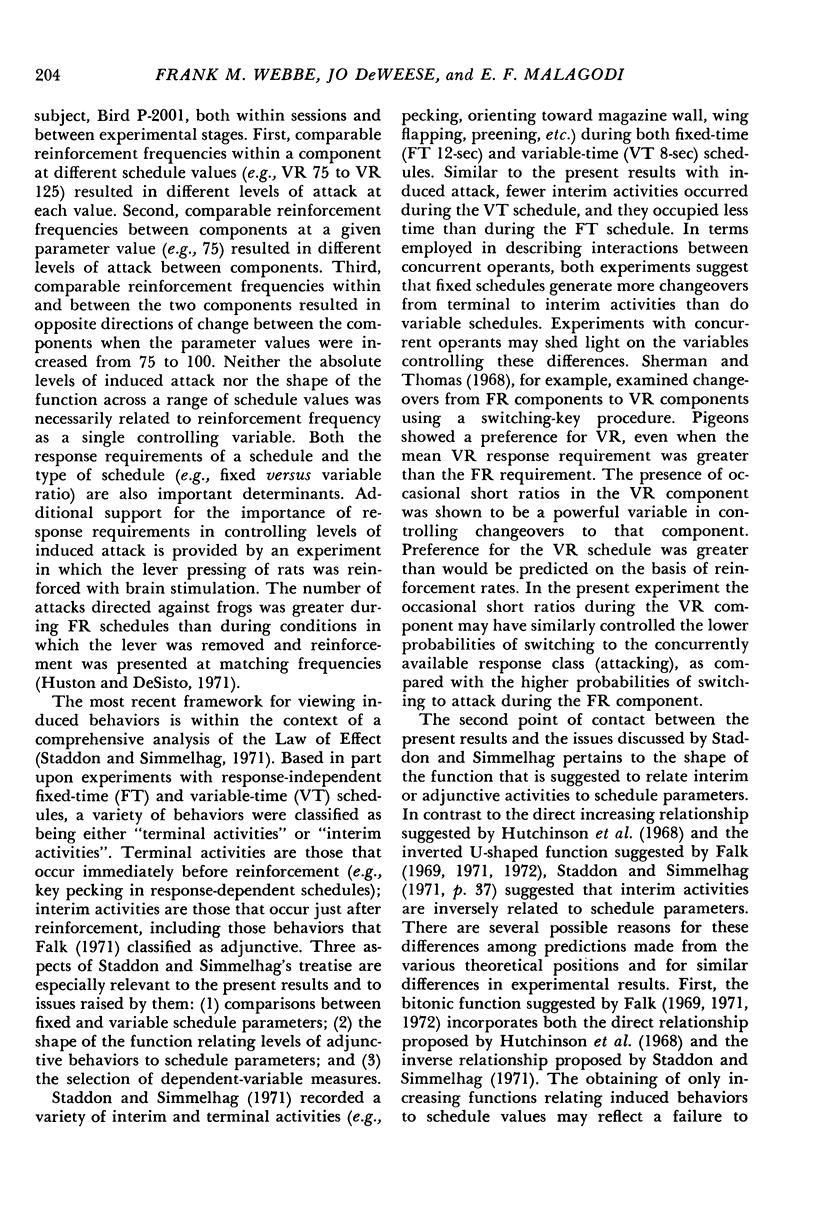

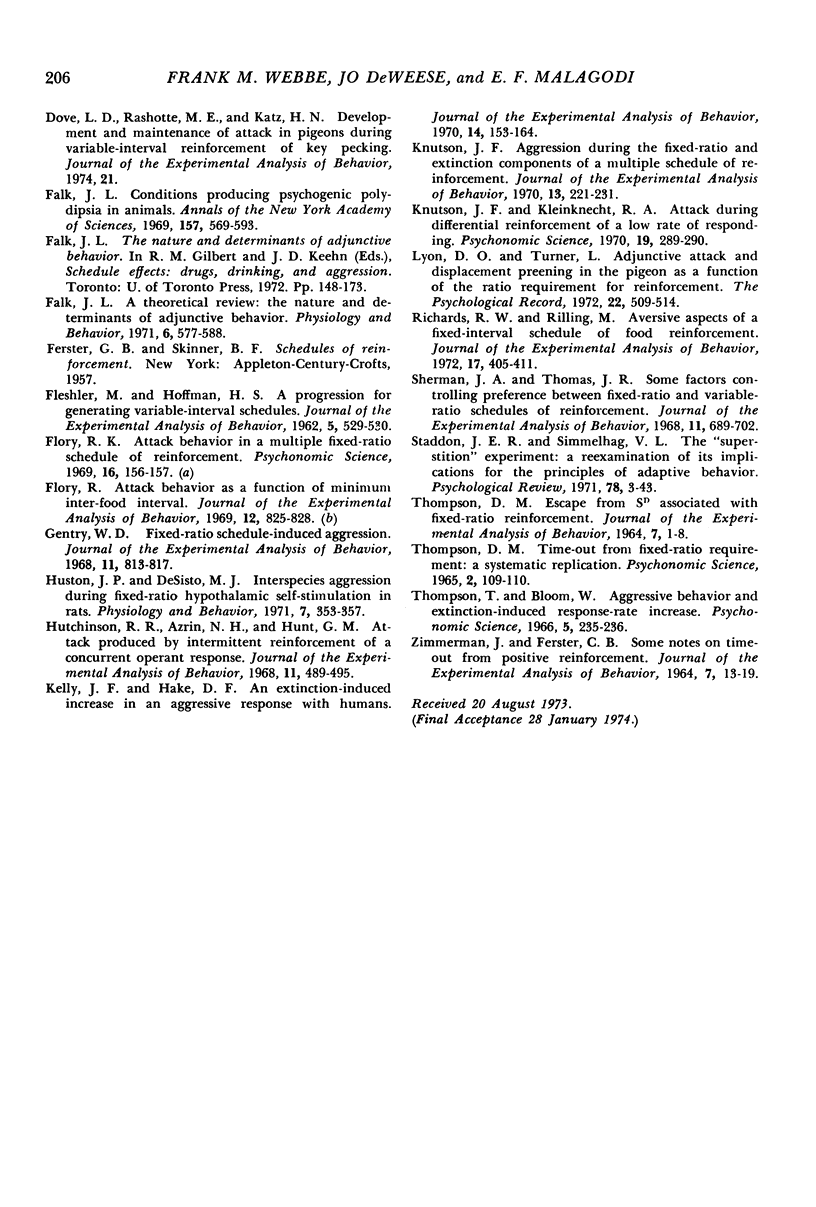
Selected References
These references are in PubMed. This may not be the complete list of references from this article.
- APPEL J. B. Aversive aspects of a schedule of positive reinforcement. J Exp Anal Behav. 1963 Jul;6:423–428. doi: 10.1901/jeab.1963.6-423. [DOI] [PMC free article] [PubMed] [Google Scholar]
- AZRIN N. H. Time-out from positive reinforcement. Science. 1961 Feb 10;133(3450):382–383. doi: 10.1126/science.133.3450.382. [DOI] [PubMed] [Google Scholar]
- Azrin N. H., Hutchinson R. R., Hake D. F. Extinction-induced aggression. J Exp Anal Behav. 1966 May;9(3):191–204. doi: 10.1901/jeab.1966.9-191. [DOI] [PMC free article] [PubMed] [Google Scholar]
- Brown T. G., Flory R. K. Schedule-induced escape from fixed-interval reinforcement. J Exp Anal Behav. 1972 May;17(3):395–403. doi: 10.1901/jeab.1972.17-395. [DOI] [PMC free article] [PubMed] [Google Scholar]
- Cherek D. R., Pickens R. Schedule-induced aggression as a function of fixed-ratio value. J Exp Anal Behav. 1970 Nov;14(3):309–311. doi: 10.1901/jeab.1970.14-309. [DOI] [PMC free article] [PubMed] [Google Scholar]
- Cohen P. S., Looney T. A. Schedule-induced mirror responding in the pigeon. J Exp Anal Behav. 1973 May;19(3):395–408. doi: 10.1901/jeab.1973.19-395. [DOI] [PMC free article] [PubMed] [Google Scholar]
- FLESHLER M., HOFFMAN H. S. A progression for generating variable-interval schedules. J Exp Anal Behav. 1962 Oct;5:529–530. doi: 10.1901/jeab.1962.5-529. [DOI] [PMC free article] [PubMed] [Google Scholar]
- Falk J. L. Conditions producing psychogenic polydipsia in animals. Ann N Y Acad Sci. 1969 May 15;157(2):569–593. doi: 10.1111/j.1749-6632.1969.tb12908.x. [DOI] [PubMed] [Google Scholar]
- Falk J. L. The nature and determinants of adjunctive behavior. Physiol Behav. 1971 May;6(5):577–588. doi: 10.1016/0031-9384(71)90209-5. [DOI] [PubMed] [Google Scholar]
- Flory R. Attack behavior as a function of minimum inter-food interval. J Exp Anal Behav. 1969 Sep;12(5):825–828. doi: 10.1901/jeab.1969.12-825. [DOI] [PMC free article] [PubMed] [Google Scholar]
- Gentry W. D. Fixed-ratio schedule-induced aggression. J Exp Anal Behav. 1968 Nov;11(6):813–817. doi: 10.1901/jeab.1968.11-813. [DOI] [PMC free article] [PubMed] [Google Scholar]
- Huston J. P., Desisto M. J. Interspecies aggression during fixed-ratio hypothalamic self-stimulation in rats. Physiol Behav. 1971 Sep;7(3):353–357. doi: 10.1016/0031-9384(71)90313-1. [DOI] [PubMed] [Google Scholar]
- Hutchinson R. R., Azrin N. H., Hunt G. M. Attack produced by intermittent reinforcement of a concurrent operant response. J Exp Anal Behav. 1968 Jul;11(4):489–495. doi: 10.1901/jeab.1968.11-489. [DOI] [PMC free article] [PubMed] [Google Scholar]
- Kelly J. F., Hake D. F. An extinction-induced increase in an aggressive response with humans. J Exp Anal Behav. 1970 Sep;14(2):153–164. doi: 10.1901/jeab.1970.14-153. [DOI] [PMC free article] [PubMed] [Google Scholar]
- Knutson J. F. Aggression during the fixed-ratio and extinction components of a multiple schedule of reinforcement. J Exp Anal Behav. 1970 Mar;13(2):221–231. doi: 10.1901/jeab.1970.13-221. [DOI] [PMC free article] [PubMed] [Google Scholar]
- Richards R. W., Rilling M. Aversive aspects of a fixed-interval schedule of food reinforcement. J Exp Anal Behav. 1972 May;17(3):405–411. doi: 10.1901/jeab.1972.17-405. [DOI] [PMC free article] [PubMed] [Google Scholar]
- Sherman J. A., Thomas J. R. Some factors controlling preference between fixed-ratio and variable-ratio schedules of reinforcement. J Exp Anal Behav. 1968 Nov;11(6):689–702. doi: 10.1901/jeab.1968.11-689. [DOI] [PMC free article] [PubMed] [Google Scholar]
- ZIMMERMAN J., FERSTER C. B. SOME NOTES ON TIME OUT FROM REINFORCEMENT. J Exp Anal Behav. 1964 Jan;7:13–19. doi: 10.1901/jeab.1964.7-13. [DOI] [PMC free article] [PubMed] [Google Scholar]


